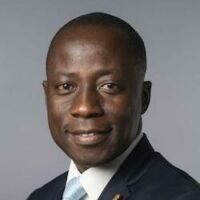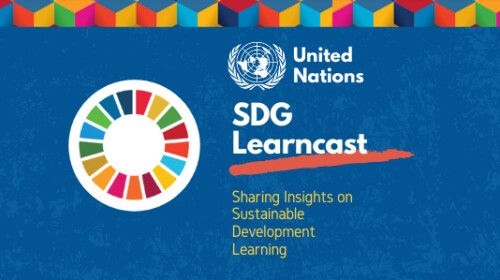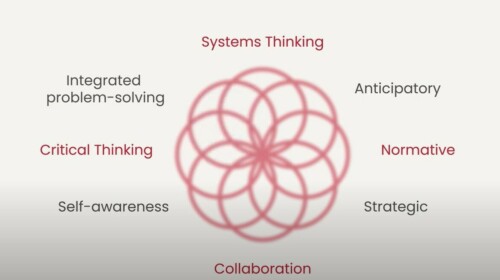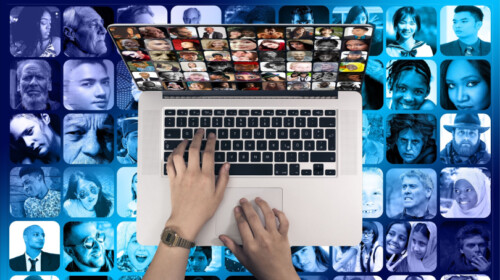Science and technology intricately mesh together with society. You cannot see one without the other. However, transformational changes in science and technology do not always advance sustainable development and reduce inequality. More people have access to smartphones than clean water or clean sanitation in some countries. Artificial intelligence and blockchain technologies are growing, but so has the number of people living in hunger.
In this episode, we speak with the co-chairs of the Science, Technology, and Innovation or STI Forum–Mr. Sergiy Kyslytsya, the Ambassador and Permanent Representative of Ukraine to the United Nations and Mr. Kennedy Godfrey Gastorn, the Ambassador and Permanent Representative of Tanzania to the United Nations. They both shared their insights on advancing science and technology achievements while also addressing global challenges of inequality, digital divide, inclusion, and climate change, to name a few issues, through collaboration among different actors in society. We need novel ways to mitigate emerging risks to scientific research and we also need to further the collaboration among scientists, researchers, and policymakers in an ongoing dialogue in networks of trust and transparency to address the global challenges.
The STI Forum of the United Nations provides this space for scientific cooperation and collaboration. It is also an important space for reflections on global development problems and discussions on how science, technology, and innovation can help contribute to approaches and solutions to achieve the 2030 Agenda for sustainable development. To know more and to register for the upcoming STI Forum, please go to https://sdgs.un.org/tfm/STIForum2022.
Want to learn more about sustainable development and learning? Subscribe to SDG Learncast. Visit the UN SDG:Learn website at www.unsdglearn.org to get the latest learning offers on the 2030 Agenda and SDGs. The transcript of the podcast is available at https://www.unsdglearn.org/podcast/.
[Transcript of the podcast]
Paulyn Duman: Welcome to the SDG learncast with me, Paulyn Duman. In every episode, I bring you insightful conversations around the subject of sustainable development and learning, helping us all to achieve a sustainable future.
In this episode, we will be speaking about science, technology and innovation otherwise known as STI, especially in the context of the STI Forum of the United Nations.
Science and technology is intricately meshed together with society. You cannot see one without the other. For example, a lot of people depend on their mobile phones, whether they are smartphones or analog phones, for daily living. A study by the Pew Research Center in 2019 reported that nearly 50% of adults said they could not live without their smartphones. In the COVID-19 pandemic, science research has tremendously helped reduce the spread of the coronavirus the same way that scientific research has addressed several diseases globally, both infectious and non-communicable ones. Innovation, which does not always require high technology or high investment, has helped millions of lives and we will speak more about this later in this episode.
For this episode, we have the honor to have with us the co-chairs of the STI Forum, Mr. Sergiy Kyslytsya, the Ambassador and Permanent Representative of Ukraine to the United Nations and Mr. Kennedy Godfrey Gastorn, the Ambassador and Permanent Representative of Tanzania to the United Nations.
Perhaps before we start, could you tell us about the Science, Technology, and Innovation Forum of the United Nations?
Ambassador Kennedy Godfrey Gastorn: The STI Forum is a venue where you facilitate interaction, matchmaking, and establishment of stakeholders, networks and partnerships. It’s also a platform that allows people to exchange ideas and share experiences on how science, technology, and innovation could further accelerate the implementation of sustainable development.
It’s also important to note that the STI Forum is able to identify lessons from the COVID-19 pandemic and discuss how to better mobilize STI for sustainable development. Furthermore, at the Forum, we anticipate that we’ll discuss how can we improve the science policy-society interface at all levels, and also increase international scientific collaboration for tackling the world’s most intractable challenges.
Now, in terms of participation, the Forum will bring together high-level policymakers and senior government officials, including ministers, scientists, research institutions, engineers, innovators, entrepreneurs, representative of organized science-acknowledged communities, the UN system and international organizations from various parts of the world. They will all come together under the umbrella of the upcoming STI Forum.
Now regarding the question on the topics that will be discussed during the forum, I can say that the forum will have two parts which are the ministerial session and which will focus primarily on science, technology and innovation for the SDGs and sustainable coming from COVID -19 pandemic. This session will also among others discuss best practices of technologies and innovation that have emerged during the COVID-19 crisis to tackle inequities or inequalities, particularly affecting vulnerable groups, including those equalizing access to good, quality healthcare, education and finance, and perhaps also, how can the national STI roadmaps and many other action plans can be aligned regionally and globally towards a more cost-effective SDGs-focused STI development.
Ambassador Sergiy Kyslytsya: The STI Forum is exceptionally important to all countries, all the United Nations, because we can’t imagine any advances in the areas of responsibility of the United Nations without applying modern technologies and advancing science achievements. As the world becomes even more sophisticated, and it is very difficult sometimes even to learn about the advance of science, let alone use it in practice. So I’m very happy that scientists and scholars all around the world are so engaged in, and are happy to work with us politicians here in the United Nations for the benefit of the countries, especially during the COVID-19 pandemic.
Paulyn Duman: Science and technology is credibility and legitimacy may have been questioned by politicians, ordinary citizens, businesses, and other parts of society. This may have created doubts about facts and evidence, but what is also important to consider is that in any scientific field, there is always scope for disagreements. Differences can result from the dissimilar methodologies, divergent sample sizes and time horizons. Such disagreements can be resolved through international scientific assessments and forums in which results can be shared, compared and tested among peers.
In your view, what can be done to ensure the legitimacy and credibility of science and be protected from the potential negative effects of politics on scientific research science?
Ambassador Kennedy Godfrey Gastorn: Science must be accessible to everyone if it is to be broadly valued and used in public and personal decision-making processes. Scientific engagement best engages the public when you acknowledge other explanations, especially about the public’s understanding and beliefs about natural and social phenomenon. To this end transdisciplinary issues such as climate change or pandemic policies, environmental sustainability, bring the scientific enterprise into direct contact with a messy world of individual values, preferences and powerful social movements and the like.
I believe that universities have a responsibility to advance science as a high reason and a public reviewed knowledge platform since scientific advice is playing an increasing role in my view, in the formulation of policy and decisions. Governments would require scientific evidence in a wide range of situations in making short-term and long-term policies, but also in setting separate agendas, including in managing crises. The most appropriate source of scientific and technical advice depends upon the purpose of which it is to be used.
Most importantly, there needs to be a clear recognition that science relies on public trust. So misinformation in and about science could easily undermine this trust. We cannot afford to let that happen.
Paulyn Duman: Scientists and engineers may have sometimes forgotten to be accountable to society. What I mean by this is that scientists and researchers sometimes neglect to communicate their insights to pressing global issues and deliberations about the future. And I believe this is the strength of the STI Forum, because it brings scientists, researchers, engineers, and innovators to find consensus to catalyze science, technology, and innovation that will give rise to new research questions that are practical and useful to society and break that image of science as an ivory tower pursuit.
Ambassador, if I were a scientific researcher, what mechanisms and resources are available to people who have ideas to help their communities? What support can they get?
Ambassador Sergiy Kyslytsya: That’s actually a great question. In fact, numerous ideas often stem from the oddest circumstances and they subsequently could truly make a difference in technologies facilitating our day-to-day life or is going impact the future or the technology that we know today.
There are multiple funds, state, private non-profits, et cetera, just like a recently established UNICEF Innovation Fund providing early stage financing for technology start-ups that have the potential to benefit humanity. Another example is the Global Innovation Fund that is a non-profit, investment fund that has its headquarters in London with offices in Washington, DC and Nairobi. It invests in the development, rigorous testing and scaling up of new products, services, business process, or policy reforms that are more cost-effective than current practice and targeted at improving the lives of the world’s poorest people.
So they are grants and they raise capital. They support these breakthrough solutions from for-profit firms, non-profit organizations, research and government agencies to maximize their impact and catalyze meaningful change because the best ideas for solving some of the world’s most critical development problems can come from anyone anywhere. We provide an open window to receive innovative ideas and assess whether they are right for investment or not.
Paulyn Duman: And would you say that it is easily accessible for people to access these existing technologies and funding, like in the examples that you’ve provided?
Ambassador Sergiy Kyslytsya: We have to assess it in very close cooperation with our constituents. And that’s why, as I said, at the beginning, it is so important that there are so many scientists and scholars that willing to get engaged with the United Nations and with the STI Forum. It is a process on the go and I’m sure that the United Nations and the Member States are very open to receive feedback from the constituents.
Paulyn Duman: We spoke about excess to mechanisms, resources, and funds for individuals, organizations, and businesses who have ideas to help their communities. Now, what I wanted to talk more about making technology accessible. Ambassador Gastorn, could you tell us more about the importance of accessibility of technologies?
Ambassador Kennedy Godfrey Gastorn: In my view, the technologies, tools, systems, and devices we use to work, communicate and manage our day-to-day lives have made life more comfortable today. And it was also supposed to blur the lines of race, gender, age and ability and so forth.
But technology has more work to do to become truly inclusive as we speak. While accessible technology makes sense from a legal and business standpoint, it also helps to promote a more inclusive society that benefits all.
So the lack of accessibility denies full digital experiences to people with disabilities, reinforcing society inequity. Building accessibility into technology and advocating for accessible technology programs in organizations can help lead to a more just world. And accessibility means making your product as usable as possible to the greatest number of people. The appeal and the efficiency of accessibility correlate to higher revenue. This is why all businesses can achieve a high return on investment by paying attention to accessibility.
Paulyn Duman: What is also important is that there are a lot of scholars and scientists, experts who are engaging more and more in social change, especially with the United Nations. But what we also see is that there is a big divide between those who have expertise, skills and knowledge within countries, and also among countries. There is also a divide or a gap, a knowledge gap, or expertise gap among young people and women, especially in developing countries. Maybe you can provide us with examples of how we can address these divides, especially the gender digital divide?
Ambassador Sergiy Kyslytsya: Right before I give him an answer to this question. I would like to say that divides exist not only between north and south, east and west, poor countries and rich countries. Divides exist even here in Manhattan or in New York City. People are living in bubbles. Even if it is the aim of your city, your place of residence, like New York city, it doesn’t mean that you have equality and equity at the same time. So we shouldn’t really simplify the issue of divide between the countries or citizens.
We can’t seem to live without the internet, but still only around half of the world’s population is connected to it. There are many reasons for this, including economic and social reasons. But for some, the internet just isn’t accessible because they have no connection. According to UNESCO, only 55% of households globally have an internet connection. In the poorest countries, this percentage drops to below 20%. An interesting fact is that globally, women are 23% less likely to have internet access than men.
This divide exists even in countries with high internet penetration. In Iraq, 98% of men can connect to the internet, but only 53% of women are able to. A similar problem is seen in global female participation in STEM, which is science, technology, engineering, and mathematics professions. Even in developed countries within the G20 countries, women represent less than 15% of ICT professionals, and the gender and skills gap is getting wider every year.
There are numerous reasons for this—from gender stereotypes and biases to societal and cultural barriers. A number of countries have put in place measures aimed to engage women and girls in STEM across the education systems. In 2018- 2019, the Australian government committed 4.5 million us dollars over four years to support long-term strategic approaches to encourage more women and girls to pursue STEM education and careers. South Korea is supporting a research fund for female student research teams in architecture, material science, and machinery, as well as computers. Germany launched in 2008, the national pact for women in STEM careers to increase women’s interest in scientific and technical studies.The initiative is bringing together politics, business signs and the media to improve the image of stem related professions in society.
Paulyn Duman: Isolation is a serious problem and getting out of our own bubbles is always an important message to remember. One of the things that is problematic is that when it comes to science, technology and innovation, no one thinks about the poor or they are seldom thought of. Pro poor innovation and technology are not usually addressed by markets because there are no incentives. So in your experience, Ambassador Kyslytsya, as you have been working in United Nations for years, and the United Nations has this role to push for ensuring that we leave no one behind, especially in the area of technology, science and innovation. How can we ensure that we develop pro poor grassroots, social innovation that solves the problem of our poor communities?
Ambassador Sergiy Kyslytsya: I think that in order to eradicate poverty, promote inclusive growth, and move economies to sustainable development trajectories over the period of 2015 to 2030, affordable technological solutions have to be developed and disseminated in a timely manner, benefiting the poor as a matter of priority. The experience of a number of developing countries shows that development policies need to actively promote pro-poor entrepreneurship and innovation strategies, taking into account the practice, a particular characteristics of poor regions and communities.
Entrepreneurship is key to job creation and inclusive growth. The disproportionate number of women, scientists, researchers, innovators, or entrepreneurs, and the seemingly stalled pace of change towards more equitable gender balance is typical of many countries with large, poor, and rural populations in particular, in many African countries and in Southeast Asia. The potential involvement of women in innovation is fundamentally important when we consider where the main impact of both urban and rural poverty is felt among its households and children.
Paulyn Duman: Innovations are less specifically targeted to sustainability strategies than to market demands. One area of innovation that is largely ignored, but has direct practical implications for sustainable development is grassroots innovation. It refers to innovation among poor people in the use of daily products, services, and processes. The National Innovation Foundation and its Honeybee Network in India have documented over 300,000 of such innovations and these innovations do not require high technology or high investment, but they directly improve the lives of poor communities, and many of them have the potential for being funded to become commercial products.
[Transition sound]
And as a final question, we have a lot of young listeners in the SDG Learncast. What would be your message to young aspiring engineers and mathematicians, scientists, and researchers, for them to be empowered to use technology science and innovation for building a sustainable future?
Ambassador Sergiy Kyslytsya: Well, I don’t know, for me, it’s more a philosophical question because being 50 plus years now, I can say that being young is a huge advantage and I encourage everyone who considers himself or herself is young to concentrate on getting as much knowledge as possible, but to be able at the same time to operate out of books, to be able to look beyond the framework that is already there because innovation is creativity, but you can’t really create something without a solid academic base. So it is certainly an art–how to match your academic knowledge and your ability to be creative.
So be creative, challenge the political establishment or the scientific establishment, but you can only be successful in challenging them if you have solid knowledge. So invest as much time as possible in getting this knowledge.
Ambassador Kennedy Godfrey Gastorn: I really want to encourage different stakeholders and listeners to participate and or follow the discussion of the Science Technology and Innovation Forum, which is planned to take place from 5th to 6th of May this year, 2022.
In my view, this is an opportunity to interact with the different scientists, planners, policymakers at many others on how best we can improve STI in the implementation of the 2030 Agenda for sustainable development. In this regard, I also encourage them to visit our STI Forum’s website, where they can get more information regarding the Forum. In conjunction with this, I also encourage them to download the Whova app or register on the Whova platform, which is found in all Android and Apple smartphones, where the upcoming STI Forum will be broadcasted.
Paulyn Duman: And that was our SDG Learncast with Ambassador Sergiy Kyslytsya and Ambassador Kennedy Godfrey Gastorn of the STI Forum.
I hope that you took away from this episode that science and society are intricately connected and that science is really about people. It is important to build relationships between practitioners in science, technology and innovation sectors and connect and engage with them in the wider socio-political context.
Second, It is possible to create new technologies and innovation that is economically profitable, inclusive, ecologically sustainable and socially responsible.
And lastly, although it is important to be a master of your subject matter and achieve excellence academically, it is important to remember that real life happens outside of libraries and laboratories. Go out there, talk to people, and ask how you can make science, technology, and innovation useful and practical to get millions out of hunger, poverty, fight climate change and make our society a better place for your generation and the future one.
You can find more of the SDG Learncast on the UN SDG:Learn website. For now, I’m Paulyn Duman. Thanks for listening.
Paulyn Duman is the Knowledge Management, Communications, and Reporting Officer at the UNSSC Knowledge Centre for Sustainable Development and is a coordinator for the Joint Secretariat of UN SDG:Learn, together with UNITAR.
The opinions expressed in the SDG Learncast podcasts are solely those of the authors. They do not reflect the opinions or views of UN SDG:Learn, its Joint Secretariat, and partners.








